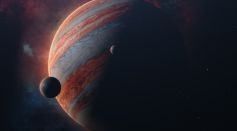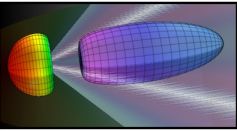Tags: Universe

Organic Molecules in Space May Hold Clues to Life's Origins

Dark Matter Breakthrough: Scientists Develop Supercold Quantum Technology To Hunt Universe’s Elusive Mystery
France, China Launch Satellite to Hunt Mightiest Explosions in Universe
New Theory Suggests Lesser Need To Hunt for Dark Matter; Additional Gravity May Be Needed To Hold a Galaxy Together
A Doughnut or a Hall of Mirrors? Experts Explores the Complex Shape of Our Universe
Cosmic Dawn Revealed: JWST Captures First Direct Image of Formation of Universe's Earliest Galaxies

NASA's TESS Discovers 126 New Planets: Unlocking the Secrets of the Universe
Do We Live in a Black Hole? Here's What Experts Say

James Webb Space Telescope Finds Most Distant Pair of Colliding Black Holes, Raising Questions Regarding Theories of Cosmology
Disruptions in Binary Stars Could Be Key to Detecting Invisible Dark Matter [Study]
Largest Space Molecules Found in Cat’s Paw Nebula Reveal How the Universe Grew So Complex

Tachyon Domination: Researchers Suggest the Universe May Be Full of Invisible Particles That Break Causality and Travel Faster Than Light
Blue Supergiants: Unraveling the Origins of Stellar Brightness Through Binary Star Mergers
Stellar Appetites Unveiled: Twin Star Studies Shed Light on the Frequency of Stars Devouring Their Planets
Gz9p3: James Webb Space Telescope Uncovers One of the Universe's Oldest Galaxies
Condor Array Telescope: Deep Imaging Observation Tool Provides New View of Very-Low-Brightness Universe
GN-z11 Mystery Unveiled: Scientists Solved Riddle of Nitrogen-Rich Galaxy
X-ray Map of Galaxy Clusters Using eROSITA Telescope Reveals a Clumpy Universe
James Webb Telescope Uncovers First Stars in Distant Galaxy GN-z11, Shedding Light on Early Universe's Secrets
Underground Excavation for DUNE Detectors Completed in South Dakota; Neutrino Detection Technology to Solve Key Mystery in Physics
Most Popular

Ancient Hotspot Found to Have Created Great Lakes 300 Million Years Ago

Mysterious Structures Discovered Beneath the Pacific Ocean, Puzzle Scientists

Largest Known Volcanic Aquifer Discovered Beneath Oregon's Cascades

New 'Supergiant' Sea Bug Found in South China Sea, Named After Darth Vader





